The solutions to Bridges in Mathematics Grade 3 Student Book Answer Key Unit 8 Module 1 can help students to clear their doubts quickly.
Bridges in Mathematics Grade 3 Student Book Answer Key Unit 8 Module 1
Bridges in Mathematics Grade 3 Student Book Unit 8 Module 1 Session 1 Answer Key
How Long Is That Bridge?
Question 1.
Study the chart below and then solve the problems.
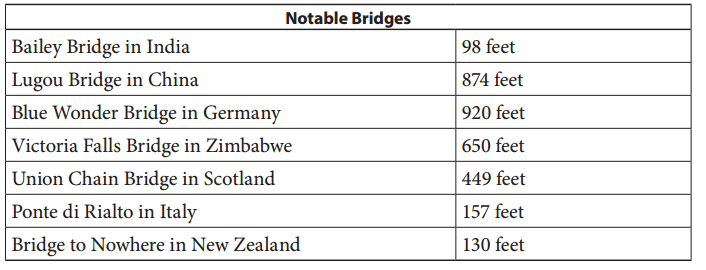
a. What is the difference in feet between the longest and the shortest bridge? Show your work.
Answer:
822 feet is the difference in feet between the longest and the shortest bridge.
Explanation:
Length of the longest bridge = 98 feet.
Length of the shortest bridge = 920 feet.
Difference:
Length of the longest bridge – Length of the shortest bridge
= 920 – 98
= 822 feet.
b. If you walked across the Union Chain Bridge and then across the Ponte di Rialto Bridge, how far would you have walked in all? Show your work.
Answer:
Total number of feet walked in all = 606.
Explanation:
Length of the Union Chain Bridge = 449 feet.
Length of the Ponte di Rialto Bridge = 157 feet.
Total number of feet walked in all = Length of the Union Chain Bridge + Length of the Ponte di Rialto Bridge
= 449 + 157
= 606.
c. If you walked 230 feet every minute, how long would it take you to cross the Blue Wonder Bridge? Show your work.
Answer:
Time taken to cross the Blue Wonder Bridge = 4 minutes.
Explanation:
Length of the Blue Wonder Bridge = 920 feet.
If you walked 230 feet every minute.Time taken
=> Time taken to cross the Blue Wonder Bridge = Length of the Blue Wonder Bridge ÷ 230
= 920 ÷ 230
= 4 minutes.
d. CHALLENGE Which bridge is 5 times as long as another bridge? How do you know?
Answer:
Victoria Falls bridge in Zimbabwe is 5 times as long as Bridge to Nowhere in New Zealand.
Explanation:
Length of the Union Chain Bridge = 449 feet.
Length of the Ponte di Rialto Bridge = 157 feet.
Bailey Bridge in india = 98 feet.
Lugou bridge in China = 874 feet.
Length of the Blue Wonder Bridge = 920 feet.
Victoria Falls bridge in Zimbabwe = 650 feet.
Bridge to Nowhere in New Zealand = 130 feet.
5 times checking:
Bailey Bridge in india = 98 feet × 5 = 490 feet. (NO)
Length of the Ponte di Rialto Bridge = 157 feet × 5 = 785 feet. (NO)
Bridge to Nowhere in New Zealand = 130 feet × 5 = 650 feet = Victoria Falls bridge in Zimbabwe.
Question 2.
Solve the problems below.
5 × __________ = 65
__________ ÷ 3 = 9
46 = ____________ × 2
90 = 15 + ___________
Answer:
Equations:
5 × __13________ = 65.
____27______ ÷ 3 = 9.
46 = _____23_______ × 2.
90 = 15 + _____75______.
Explanation:
Given equations:
5 × ?? = 65.
=> ?? = 65 ÷ 5
=> ?? = 13.
?? ÷ 3 = 9.
=> ?? = 9 × 3
=> ?? = 27.
46 = ?? × 2.
=> 46 ÷ 2 = ??
=> 23 = ??.
90 = 15 + ??.
=> 90 – 15 = ??
=> 75 = ??.
Bridges in Mathematics Grade 3 Student Book Unit 8 Module 1 Session 2 Answer Key
Work Place Instructions 8A Weight Lifting
1. At the Weight Lifting event station, Player 1 and Player 2 both plan their weight lifts.
- Each player gets a copy of the 8A Weight Lifting Record Sheet.
- Each player chooses an item to weight lift and records the item chosen on the record sheet.
- Each player estimates the mass of 1 item and records their estimate on the record sheet.
- Using the pan balance and metric weights, each player measures the mass of 1 item and records it on the record sheet.
- If measuring the mass of 1 item is difficult, measure the mass of 10 items and divide to find the mass of 1.
- Each player estimates how many of this item she can grab in one hand, then estimates the mass of that many of the item and records that estimate on the record sheet.
- Jami I think I can grab 30 of these little cubes. Each cube has a mass of 1 gram, so I’m going to put 30 grams.
- Rick The dice are bigger than the cubes, but I bet I can grab 30 of them anyway. One of them is about 5 grams, so I’m going to put 150 grams for my estimate.
2. Player 1 grabs as many of her chosen item as she can hold in one hand. Then she counts the items, finds their total mass, and records the total mass on the record sheet.
3. Player 2 repeats this process with his chosen item.
4. Players calculate the difference between their estimates and the actual mass they grabbed and record the differences in the table.
5. The winner is the player whose grab came closest to their estimate.
6. Players repeat the game, choosing new items to grab.
Work Place Instructions 8B Wacky Discus
1. Each player gets an 8B Wacky Discus Record Sheet and records the Wacky Discus area on the sheet.
- Players use the area posted at the station. If no area is posted, players agree on an area to use for the event.
2. Each player writes all of the possible pairs of dimensions for the chosen area on their record sheet.
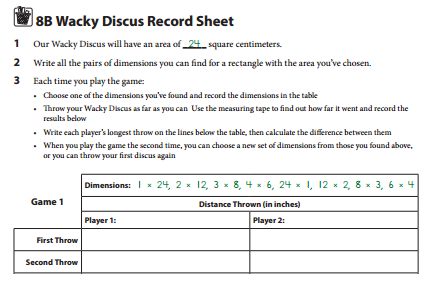
3. Each player chooses one of the pairs of dimensions to make their Wacky Discus and records the dimensions in the table. Then each player measures the dimensions onto a sheet of paper and cuts out their Wacky Discus.
4. Each player throws their Wacky Discus three times. Players record the results on their record sheets.
- When throwing, the players stand with toes just barely on the starting line.
- After throwing, players use the measuring tape to measure a straight line from the starting line to the nearest edge of the discus.
- Players record the measurement to the nearest quarter-inch.
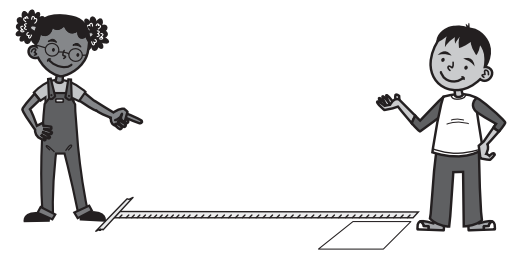
5. Each player calculates the difference between his best distance and the other player’s best distance and records that difference on the record sheet.
6. Players repeat the event. They can either keep the same discus, or make a new discus with the same area but different dimensions.
Game Variation
A. Make a triangle, trapezoid, or parallelogram discuss instead of a rectangle.
Answer:

Explanation:
A triangle is a polygon with three sides having three vertices. The angle formed inside the triangle is equal to 180 degrees.
A trapezoid is also called a trapezium in some parts of the world and it is a type of quadrilateral with one pair of opposite sides parallel to each other.
A parallelogram is a two-dimensional geometrical shape whose sides are parallel to each other.
How Big Is That School?
Jose made a scale model of his school, Roebling Elementary. A drawing of the model is shown below.
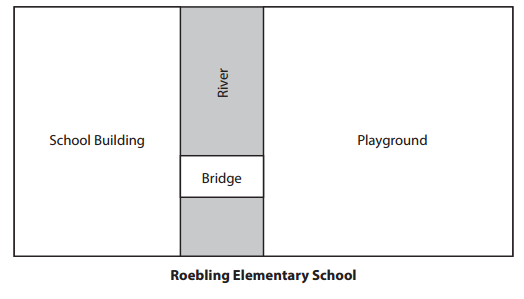
Question 1.
Using centimeters, measure the dimensions of the school building, playground, river, and bridge.
- Record the dimensions of each part of the model in the table below.
- Find the area of each part of the model and record the areas in the table below.
Hint: Remember that the river runs underneath the bridge.

Answer:

Explanation:
Length of the school building = 1200 cm.
Breadth of the school building = 900 cm
Area of the school building = Length of the school building × Breadth of the school building
= 1200 × 900
= 10,80,000 square cm.
Length of the playground = 300 cm
Breadth of the playground = 120 cm
Area of the playground = Length of the playground × Breadth of the playground
= 300 × 120
= 36,000 square cm.
Length of the River = 1200 cm.
Breadth of the River = 850 cm.
Area of the River = Length of the River × Breadth of the River
= 1200 × 850
= 10,20,000 square cm.
Length of the Bridge = 2000 cm.
Breadth of the Bridge = 950 cm.
Area of the Bridge = Length of the Bridge × Breadth of the Bridge
= 2000 × 950
= 19,00,000 square cm.
e. What is the area of the entire model of Roebling Elementary School? Show your work.
Answer:
Total area of the entire model of Roebling Elementary School = 40,36,000 square cm.
Explanation:
Area of the school building = 10,80,000 square cm.
Area of the playground = 36,000 square cm.
Area of the River = 10,20,000 square cm.
Area of the Bridge = 19,00,000 square cm.
Total area of the entire model of Roebling Elementary School = Area of the school building + Area of the playground + Area of the River + Area of the Bridge
= 10,80,000 + 36,000 + 10,20,000 + 19,00,000
= 11,16,000 + 10,20,000 + 19,00,000
= 21,36,000 + 19,00,000
= 40,36,000 square cm.
Question 2.
Solve the problems below.
5 × ___________ = 90
_________ ÷ 15 = 6
__________ × 3 = 45
90 = 2 × _____________
Answer:
Equations:
5 × ____18_______ = 90.
____90_____ ÷ 15 = 6.
___15_______ × 3 = 45.
90 = 2 × ______45_______.
Explanation:
Given Equations:
5 × ?? = 90.
=> ?? = 90 ÷ 5
=> ?? = 18.
?? ÷ 15 = 6.
=> ?? = 6 × 15
=> ?? = 90.
?? × 3 = 45.
=> ?? = 45 ÷ 3
=> ?? = 15.
90 = 2 × ?? .
=> 90 ÷ 2 = ??
=> 45 = ??.
Bridges in Mathematics Grade 3 Student Book Unit 8 Module 1 Session 3 Answer Key
How Big Is That Bridge?
Question 1.
Ariana and Maya built the model beam bridges shown below.

a. What is the area of Ariana’s bridge deck? Show your work.
Answer:
45 square inches is the area of Ariana’s bridge deck.
Explanation:
Length of the Ariana’s bridge deck = 15 inches.
Breadth of the Ariana’s bridge deck = 3 inches.
Area of the Ariana’s bridge deck = Length of the Ariana’s bridge deck × Breadth of the Ariana’s bridge deck
= 15 × 3
= 45 square inches.
b. What is the area of Maya’s bridge deck? Show your work.
Answer:
Area of the Maya’s bridge deck = 48 square inches.
Explanation:
Length of the Maya’s bridge deck = 12 inches.
Breadth of the Maya’s bridge deck = 4 inches.
Area of the Maya’s bridge deck = Length of the Maya’s bridge deck × Breadth of the Maya’s bridge deck
= 12 × 4
= 48 square inches.
c. What is the difference between the areas of the two decks? Show your work.
Answer:
3 square inches is the difference between the areas of the two decks.
Explanation:
Area of the Maya’s bridge deck = 48 square inches.
Area of the Ariana’s bridge deck = 45 square inches.
Difference:
Area of the Maya’s bridge deck – Area of the Ariana’s bridge deck
= 48 – 45
= 3 square inches.
d. Ariana’s bridge spanned 10\(\frac{1}{2}\) inches. Maya’s bridge spanned 8\(\frac{1}{2}\) inches. How much longer was Ariana’s span? Show your work.
Answer:
55.5 inches longer was Ariana’s span.
Explanation:
Area of the Maya’s bridge deck = 48 square inches.
Maya’s bridge spanned 8\(\frac{1}{2}\) inches.
=> Area of the Maya’s bridge deck = 48 + 8\(\frac{1}{2}\)
= 48 + {[(8 × 2) + 1] ÷ 2}
= 48 + [(16 + 1) ÷ 2]
= 48 + (17 ÷ 2)
= (96 + 17) ÷ 2
= 113 ÷ 2
= 56.5 inches.
Area of the Ariana’s bridge deck = 45 square inches.
Ariana’s bridge spanned 10\(\frac{1}{2}\) inches.
=> Area of the Ariana’s bridge deck = 45 sq inches+ 10\(\frac{1}{2}\)
= 45 + {[(10 × 2) + 1] ÷ 2}
= 45 + [(20 + 1) ÷ 2]
= 45 + (21 ÷ 2)
= (90 + 21) ÷ 2
= 111 ÷ 2
= 55.5 inches.
Question 2.
Solve the problems below.
20 × ___________ = 120
____________ ÷ 8 = 9
45 = ___________ × 5
90 = 30 × ___________
Answer:
Equations:
20 × _____6______ = 120.
_____72_______ ÷ 8 = 9.
45 = _____9______ × 5.
90 = 30 × ____3_______.
Explanation:
Given Equations:
20 × ?? = 120.
=> ?? = 120 ÷ 20
=> ?? = 6.
?? ÷ 8 = 9.
=> ?? = 9 × 8
=> ?? = 72.
45 = ?? × 5.
=> 45 ÷ 5 = ??
=> 9 = ??.
90 = 30 × ??.
=> 90 ÷ 30 = ??
=> 3 = ??.
Bridges in Mathematics Grade 3 Student Book Unit 8 Module 1 Session 4 Answer Key
How Much Weight Does That Bridge Hold?
Question 1.
Mr. Weldele’s class made small beam bridges out of craft sticks and paper. Examine the data in the table and answer the questions below.

a. How much more weight did Team E’s bridge hold than Team C’s bridge? Show your work.
Answer:
1 grams per square inch more weight Team E’s bridge hold than Team C’s bridge.
Explanation:
Weight of team C = 48 grams.
Area of team C = 6 inches.
Load Per square inch of team C = Weight of team C ÷ Area of team C
= 48 ÷ 6
= 8 grams per square inch.
Weight of team E = 54 grams.
Area of team E = 6 inches.
Load Per square inch of team E = Weight of team E ÷ Area of team E
= 54 ÷ 6
= 9 grams per square inch.
Difference:
Load Per square inch of team E – Load Per square inch of team C
= 9 grams – 8 grams
= 1 grams per square inch.
b. In bridge design, one important factor is load per square unit—the amount of weight that an area of the bridge can hold. Team A calculated the load per square inch of their bridge as follows:
88 grams ÷ 4 square inches = 22 grams per square inch
Calculate the loads per square inch of the bridges made by the other teams and enter them on the table above. Use the space here to do your calculations.
Answer:

Explanation:
Weight of team A = 88 grams.
Area of team A = 4 inches.
Load Per square inch of team A = Weight of team A ÷ Area of team A
= 88 ÷ 4
= 22 grams per square inch.
Weight of team B = 24 grams.
Area of team B = 8 inches.
Load Per square inch of team B = Weight of team B ÷ Area of team B
= 24 ÷ 8
= 3 grams per square inch.
Weight of team C = 48 grams.
Area of team C = 6 inches.
Load Per square inch of team C = Weight of team C ÷ Area of team C
= 48 ÷ 6
= 8 grams per square inch.
Weight of team D= 36 grams.
Area of team D = 9 inches.
Load Per square inch of team D = Weight of team D ÷ Area of team D
= 36 ÷ 9
= 4 grams per square inch.
Weight of team E = 54 grams.
Area of team E = 6 inches.
Load Per square inch of team E = Weight of team E ÷ Area of team E
= 54 ÷ 6
= 9 grams per square inch.
Question 2.
Solve the problems below.
5 × 60 = ___________
___________ × 4 = 28
120 = ____________ × 4
____________ ÷ 4 = 14
Answer:
Equations:
5 × 60 = ____300_______.
_____7______ × 4 = 28.
120 = ______30______ × 4.
____56________ ÷ 4 = 14.
Explanation:
Given equations:
5 × 60 = ?? .
=> 300 = ??
?? × 4 = 28.
=> ?? = 28 ÷ 4
=> ?? = 7.
120 = ?? × 4.
=> 120 ÷ 4 = ??
=> 30 = ??.
?? ÷ 4 = 14.
=> ?? = 14 × 4
=> ?? = 56.
Bridges in Mathematics Grade 3 Student Book Unit 8 Module 1 Session 5 Answer Key
Arch Bridges Bar Graph
Make a bar graph to represent the data from the Arch Bridges table. Write the team name below each bar, and write the actual number of grams above each bar.
Weight Data for Each Team
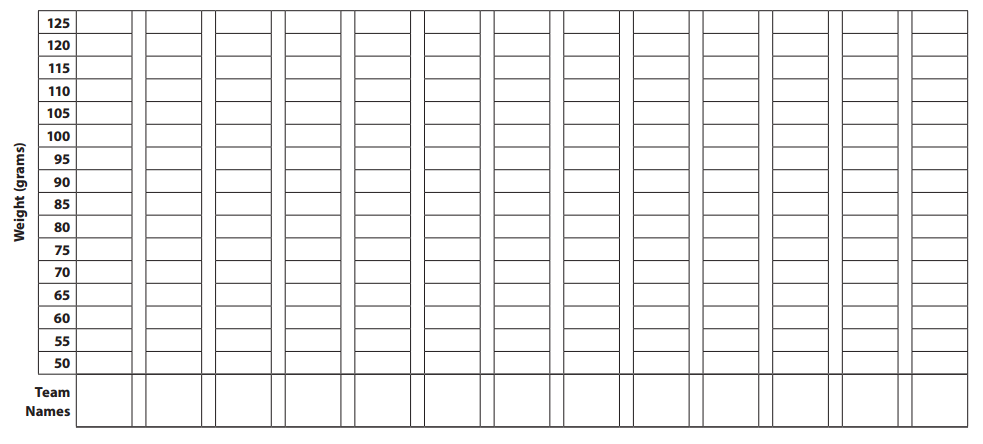
Answer:

Explanation:

Arch Bridge Data on a Line Plot
Question 1.
Ms. Fisher’s class made arch bridges out of books and card stock. Every bridge had the same size of arch and the same type of deck. Here is the data they collected.

a. Draw an X for each team’s data on the line plot below. Gayle’s data has been added to the line plot already.

Answer:
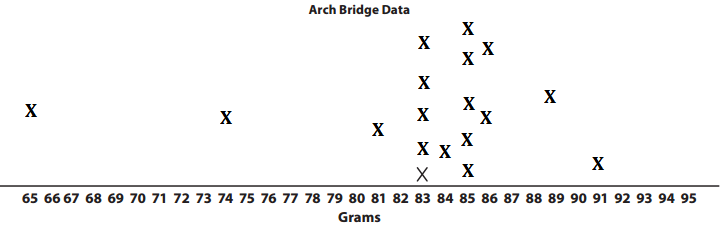
Explanation:
Given data:

b. Write two things you notice about the data on the line plot.
Answer:
Two things noticed about the data on the line plot:
1. Most builders liked are 83 and 85 weight bridges.
2. Lower weight of bridge is Ty of 74 grams.
Explanation:
Line plot of the data:

Question 2.
Solve the problems below.
10 × __________ = 1,000
_________ ÷ 100 = 10
200 = ________ × 10
_________ ÷ 20 = 10
Answer:
Equations:
10 × ___100_______ = 1,000.
____1000_____ ÷ 100 = 10.
200 = ___20_____ × 10.
___200______ ÷ 20 = 10.
Explanation:
Given equations:
10 × ?? = 1,000.
=> ?? = 1000 ÷ 10
=> ?? = 100.
?? ÷ 100 = 10.
=> ?? = 10 × 100
=> ?? = 1000.
200 = ?? × 10.
=> 200 ÷ 10 = ??
=> 20 = ??.
?? ÷ 20 = 10.
=> ?? = 10 × 20
=> ?? = 200.